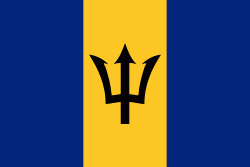Saint Peter (Saint Peter)
The Parish of Saint Peter ("St. Peter") is one of eleven parishes in the Caribbean island country of Barbados. It is named after the Christian Apostle and patron saint, Saint Peter. It is located in the north of Barbados, and is the only parish besides Saint Lucy that extends from the east coast to the west.
The Barbados "Platinum Coast," which extends through Saint Peter from the parish of Saint James just to the south, has helped to make Saint Peter a tourist hot spot. The parish is surrounded with white sand beaches, including those along Mullins Bay. Its topography includes rolling hills and terraces, some of which are still covered by sugar cane, which was the island's chief cash crop during its colonial period. Within Saint Peter are also large tourist sites such as the Port St. Charles and Port Ferdinand marinas. Other lavish resorts include Schooner Bay, St. Peter's Bay and The Palazzate.
The Barbados "Platinum Coast," which extends through Saint Peter from the parish of Saint James just to the south, has helped to make Saint Peter a tourist hot spot. The parish is surrounded with white sand beaches, including those along Mullins Bay. Its topography includes rolling hills and terraces, some of which are still covered by sugar cane, which was the island's chief cash crop during its colonial period. Within Saint Peter are also large tourist sites such as the Port St. Charles and Port Ferdinand marinas. Other lavish resorts include Schooner Bay, St. Peter's Bay and The Palazzate.
Map - Saint Peter (Saint Peter)
Map
Country - Barbados
 |
 |
| Flag of Barbados | |
Inhabited by Kalinago people since the 13th century, and prior to that by other Amerindians, Spanish navigators took possession of Barbados in the late 15th century, claiming it for the Crown of Castile. It first appeared on a Spanish map in 1511. The Portuguese Empire claimed the island between 1532 and 1536, but abandoned it in 1620 with their only remnants being an introduction of wild boars for a good supply of meat whenever the island was visited. An English ship, the Olive Blossom, arrived in Barbados on 14 May 1625; its men took possession of the island in the name of King James I. In 1627, the first permanent settlers arrived from England, and Barbados became an English and later British colony. During this period, the colony operated on a plantation economy, relying on the labour of African slaves who worked on the island's plantations. Slavery continued until it was phased out through most of the British Empire by the Slavery Abolition Act 1833.
Currency / Language
| ISO | Currency | Symbol | Significant figures |
|---|---|---|---|
| BBD | Barbados dollar | $ | 2 |
| USD | United States dollar | $ | 2 |
| ISO | Language |
|---|---|
| EN | English language |















